| Administrator Handbook | Table of contents |
|
Concepts of MIB management and MIB compilation in Loriotpro
Cleaning of the LoriotPro MIB Database
The MIB compiler tool from LoriotPro is a key tool in SNMP management. The MIB compiler tool allows you to extend the management capabilities of Loriotpro to any standard and proprietary SNMP hardware and software. With the MIB compiler you can add SNMP objects declare in MIB files to the MIB tree . You simply get the MIB file of the device you want to manage and compile it with the LoriotPro MIB compiler.
MIB files contains the description of the SNMP objects that can be used to manage devices and software. Most of the MIB files are standard and commonly supported by all devices.

However, most of hardware and software have proprietary SNMP objects that are not defined in the standard MIB. To handle them hardware constructors and software editors have developed their own MIB ( proprietary MIB ). These proprietary MIB should be added (compiled in LoriotPro) to be able to perform the management over this proprietary hardware or software.
To be able to use these SNMP objects, it is necessary to retrieve this proprietary MIB files from the editor.
We do not provide all existing proprietary MIB files with our solution. We provide by default all the standard MIB files defined in Request For Comments (RFC).
Proprietary MIB files are available on the device constructor or software editor Web site.
When you have a new MIB file, you should copy it into the /mibs directory and compile it to be able to see it in the MIB tree.
The following chapter explains the concepts of MIB management
within LoriotPro.
When LoriotPro starts, it reads a descriptive file (lmib.txt) and loads in memory all the SNMP objects in a DataBase.
These SNMP objects are then visible in the MIB tree and can be used
to make SNMP requests on devices.
The /bin/lmib.txt file is created with the LoriotPro MIB compiler. The LoriotPro MIB compiler can add (compile) to the startup database config file any MIB files that are located in the /bin/mibs directory.
Warning: Even if the database contains the entire MIB SNMP object, all SNMP object attributes are not stored in it. Thus it is still necessary to keep in the /bin/mibs subdirectory all the MIB files used to make the compilation.
If the /bin/lmib.txt file does not exist, LoriotPro creates a new file by reading the /bin/config/mib-database/lmib.lda file.
The lmib.lda file is the default startup database config file provided with LoriotPro. This one is absolutely necessary for using all the LoriotPro Plug-in. This file is a copy of the last generated lmib.txt if you have performed compilation and use afterwards the option 'save to startup datatbase'. In other case it is a copy of the default lmib.txt file provided at installation.
At the end of the startup process, if both files does not exist, LoriotPro reads the /bin/kernel.mib file and create with an on the fly compilation a minimum internal MIB database with the common SNMP SNMP objects defined in standard MIBs files issued from the RFC (Request for Comments). The kernel.mib file describes the MIB tree from the root to the MIB2 node and its underneath mandatory SNMP objects (system, interface, snmp, ip, tcp...)

List of MIB file definition load from the kernel.mib file
LoriotPro also loads any other MIB files that are listed in the loriotpro.ini file under the [MIB_LOAD] section. MIB file specified here are compiled on the fly when LoriotPro starts.
[MIB_LOAD]
enterprises-number.mib
[end]
By default the entreprise-number.mib is loaded by this way and creates the node "entreprise" in the tree. Well known company nodes are automatically created.
Remark : An error message could appear in the initialisation window when starting LoriotPro because the enterprises-number.mib file is already loaded in by the lmib.txt file.
Finally the lmib.txt file is read and SNMP objects are loaded in memory.
To run the MIB compiler from the main menu select :
MIB>MIB MIB compiler…
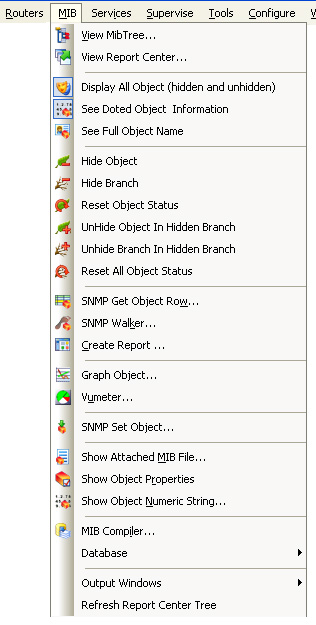
MIB compiler Tool
The following window is displayed
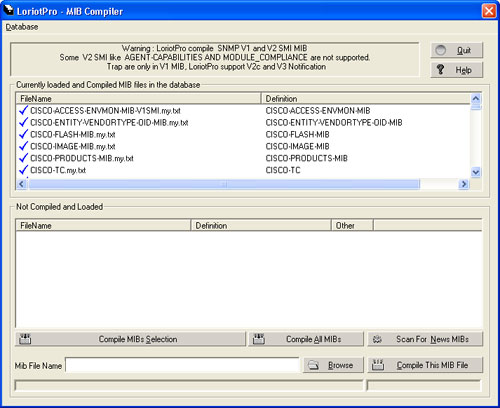
MIB MIB compiler MIB compiler window
The window has two list boxes.
The Currently loaded and Compiled MIB files in the database list box contains all the MIB file that are in the current database and loaded in memory.
The Not Compiled and loaded list box contains the MIB file that are in the /mibs directory and not currently
in the database.
File containing SNMP objects loaded in memory have the following icon ![]()
File containing SNMP objects but not loaded in memory have the following
icon ![]()
Let us add a new MIB file from Cisco to the list of supported MIB file.
Gathering MIB file from a constructor
The first step consists of downloading from the constructor WEB site the last version of its file definitions. The language used to build a file definition has evolved and two versions are existing. LoriotPro compiles both of them and therefore could handle all proprietary SNMP SNMP objects. In our example, both files used for Cisco products could be downloaded.
Example of the CISCO MIB download web page.
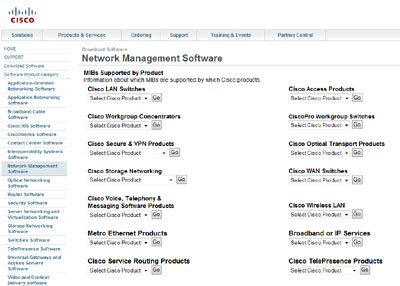
Ciscov1.tar.gz
Ciscov2.tar.gz
Uncompress them in the bin/mibs directory with your preferred tool.
Generate a list of file definitions.
Once the previous step ended, click on Scan for News MIBs button to force the software to re-initialize the list of MIB that could be available for a new compilation.


Select Yes.
After little time, the list is displayed and the new files are visible but still not compiled and loaded in memory.
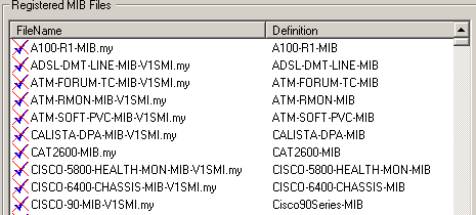
Liste de fichier de MIB Cisco
At this point, you could either:
- compile all MIB file listed in the list box by clicking
on Compile All MIBs
- performs a MIB compilation of selected files by clicking on Compile MIBs selection
- compile a single file
For a selective MIB compilation, press the CTRL key and click on the file that you want to compile. When finished, click on the " Compile MIBs Selection " button.

Performing a selective compilation
A single file could be compiled. Browse the directory where your file is loacted and select it then click on the Compile this MIB File button.
![]()
The compilation could take several minutes on a slow PC. The LoriotPro MIB compiler is very performing and if the processor speed is higher than 500 Mhz, all the MIB files would be compiled in few minutes.
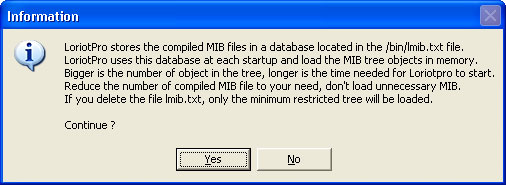
Compilation confirmation window
During the compilation process, the current compiled file and the number of new compiled SNMP objects is displayed in the lower status bar.
![]()
The startup configuration file /lmib.txt is managed from the menu.
When you do a compilation the MIB object are all stored in the memory and are are fully usable until you close LoriotPro. Th role of the lmib.txt is to reload these SNMP objects in memory at the next restart that why it is necessary to save them after the compilation process. Answering NO means that the modification will be lost at the next restart of Loriotpro.

When you have done a new compilation it is necessary to save the new configuration to this database config file.
This config will be used the next time that you start LoriotPro.
Remark: If you want you could load in memory the new MIB SNMP objects and save it to the the startup database lmib.txt afterwhile. The menu allows you to specify the database to load at startup.
To save the current compilation, open the menu Database and select the Save to Startup database.
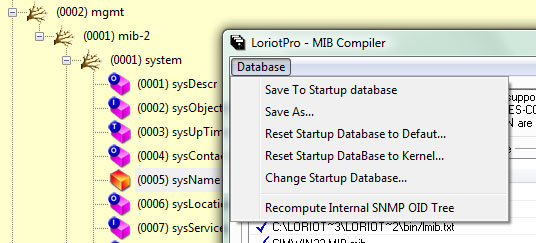
Other option allows you to:
Save to Startup database: This option saves your current compilation into the /bin/lmib.txt file and into the /bin/config/mib-database/lmib.lda file. The previous lmib.lda file is renamed lmib-bak.lda. With the lmib-bak.lda you could restore your previous configuration. Use the Change Startup database for restoring the bak file.
Save As - Save the current compilation into a Database config file. This file will not be loadded at the next Startup. With this option you could manage multiple startup configuration files. This option is used conjointly with the Change startup database option. Files are located in the /bin/config/mib-database subdirectory.
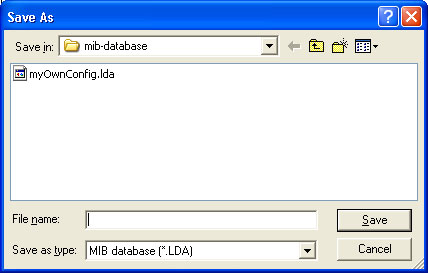
Reset Startup Database to Default - The startup config file lmib.txt will be cleared and re-initialized to its initial default configuration. All the additional MIB file compiled since the LoriotPro installation will be lost. This option is necessary for removing all proprietary MIB file from the list. The default file is created with the lmib.dat file. The lmib.dat file contains all the minimum MIB files that are required for LoriotPro and its Plug-in. Do not delete, move or change it.
See section Cleaning of the LoriotPro MIB Database
Reset Startup Database to Kernel - By selecting Reset Startup Database to Kernel the database will be initialized by a file (with mandatory MIB object) called kernel.mib and contains the MIB RFC 1155, RFC 1158, RFC 1213, RFC 3418, RFC 1904, RFC 1903.
See section Cleaning of the LoriotPro MIB Database
Change Startup Database - Allow you to select another configuration file at startup. Files are located in the /bin/config/mib-database subdirectory. This operation copies the .lda file into the lmib.txt file located in the /bin directory.
Reset Internal SNMP OID tree - It could be necessary in specific case to reset the tree. If you do not see object after a compilation better check the log file for errors. MIB files frequently use Import files, if these one are not present in the MIB directory, after the compilation MIB objects are not visible in the MIB tree.

Select Yes or No. If you answer YES and you want to cancel your action later on, you can restore the lmib.txt backup file and replace the newly created one, after restarting LoriotPro.
After compiling, the result of the compilation is displayed showing the performed tasks. Look at the file to see if object import is successful. Any error in the MIB file structure, duplicate name of missing father node is reported.
Example of information text
Start: Load and Analyse MIB file : ----------------------------------
mibs/CISCO-6400-CHASSIS-MIB-V1SMI.my at Tue Feb 19 18:16:11 2002
Found MIB Definitions [CISCO-6400-CHASSIS-MIB]
Import MIB [SNMPv2-SMI-v1] registered
Import MIB [SNMPv2-SMI-v1] allready Loaded from (SNMPv2-SMI-V1SMI.my)
for mibs/CISCO-6400-CHASSIS-MIB-V1SMI.my
Import MIB [SNMPv2-TC-v1] registered
Import MIB [SNMPv2-TC-v1] allready Loaded from (SNMPv2-TC-V1SMI.my)
for mibs/CISCO-6400-CHASSIS-MIB-V1SMI.my
Import MIB [IF-MIB] registered
Import MIB [IF-MIB] allready Loaded from (rfc2863.mib) for mibs/CISCO-6400-CHASSIS-MIB-V1SMI.my
Total : Node [11944/11852] Node Error [1] Node Warning [14] Token Registered
[269] 2 s Tue Feb 19 18:16:13 2002
The MIB file should now appears with the icon ![]() in the upper
list box
in the upper
list box
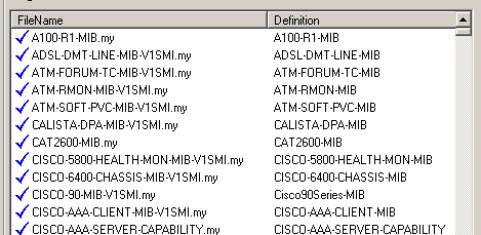
When you use the MIB compiler, the MIB tree with SNMP objects is updated and the new SNMP objects are immediately available for use in the various LoriotPro tools.
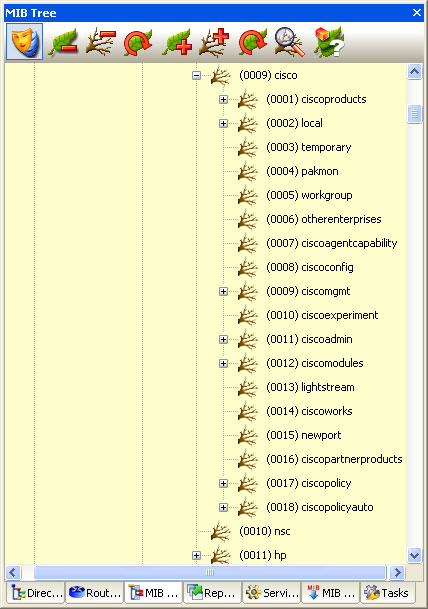
The updated MIB Tree.
Remark: During the compilation, the SNMP SNMP objects from trap version 1 type and founded in the file definitions are inserted in the MIB tree and get a specific icon.
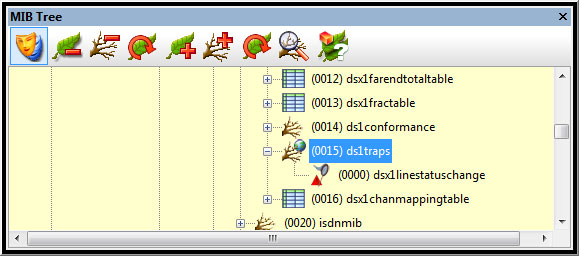
V1Trap in the 'MIB Tree'
The software creates a trap.txt file in the /bin directory with all version 1 trap type.
This file is used by the Event Manager to perform an association between the trap ObjectID and a dedicated number.
Extract of file : trap.txt
atmsoftpvctraps.1 atmsoftpvccallfailurestrap
cisco6400chassismibnotificationprefix.1 cisco6400chassisfailurenotification
x25.1 x25restart
x25.2 x25reset
snmp.5 egpneighborloss
dot1dbridge.1 newroot
dot1dbridge.2 topologychange
rmon.1 risingalarm
rmon.2 fallingalarm
docsdevtrapconformance.1 docsdevcminittlvunknowntrap
docsdevtrapconformance.2 docsdevcmdynservreqfailtrap
docsdevtrapconformance.3 docsdevcmdynservrspfailtrap
docsdevtrapconformance.4 docsdevcmdynservackfailtrap
docsdevtrapconformance.5 docsdevcmbpiinittrap
docsdevtrapconformance.6 docsdevcmbpkmtrap
docsdevtrapconformance.7 docsdevcmdynamicsatrap
docsdevtrapconformance.8 docsdevcmdhcpfailtrap
docsdevtrapconformance.9 docsdevcmswupgradeinittrap
docsdevtrapconformance.10 docsdevcmswupgradefailtrap
docsdevtrapconformance.11 docsdevcmswupgradesuccesstrap
docsdevtrapconformance.12 docsdevcmswupgradecvcfailtrap
docsdevtrapconformance.13 docsdevcmtodfailtrap
docsdevtrapconformance.14 docsdevcmdccreqfailtrap
In this file the version 1 trap names are encoded :
docsdevtrapconformance.14 docsdevcmdccreqfailtrap
In our example above the trap docsdevcmdccreqfailtrap is a specific trap with assigned number 14 and OID docsdevtrapconformance.
![]() Warning : The trap.txt file is created in append mode.
If you perform several consecutive compilations, you have to edit it and suppress
redundant entries. In the below example bold lines have to be suppressed.
Warning : The trap.txt file is created in append mode.
If you perform several consecutive compilations, you have to edit it and suppress
redundant entries. In the below example bold lines have to be suppressed.
Extrait du fichier : trap.txt
x25.1 x25restart
x25.2 x25reset
dot1dbridge.1 newroot
dot1dbridge.2 topologychange
rmon.1 risingalarm
rmon.2 fallingalarm
llecointe.1 loriotidsprobetrap
x25.1 x25restart
x25.2 x25reset
dot1dbridge.1 newroot
dot1dbridge.2 topologychange
rmon.1 risingalarm
Adding MIB file to the LoriotPro MIB Database is an operation performed with the MIB Compiler of LoriotPro.
As a reminder, the MIB database is built by adding MIB file. The MIB database is relevant for LoriotPro because it is required for finding the OID of a named object or finding the object named from its OID. (example : sysName <-> 1.3.6.1.2.1.1.5.0)
Since the Version 5 of LoriotPro the MIB compiler is also used to perform cleaning of the LoriotPro MIB database of unnecessary MIB objects. In other terms, you can remove entries that you don’t want to see in your MIB tree.
But there is a very big difference between adding new MIB file in the MIB database of Loriotpro and removing MIB file.
Adding MIB files to the MIB database can be done one by one with the MIB compiler as long as you follow the rules of MIB dependencies (IMPORT entries in the MIB).
Removing MIB file can not be done on a per file basis. The MIB database should be completely cleaned first and then MIB file can be added and the MIB tree rebuilt as you wanted it to be.
For this goal, two options are available in the MIB Compiler Menu.

By selecting Reset Database Startup to Default the base will be built with the current MIB (standard RFC) as well as some owners of some manufacturers, publishers and partners LUTEUS.
By selecting Reset Startup Database to Kernel the database will be initialized by a file (with mandatory MIB object) called kernel.mib and contains the MIB RFC 1155, RFC 1158, RFC 1213, RFC 3418, RFC 1904, RFC 1903.
A confirmation is offered prior validation
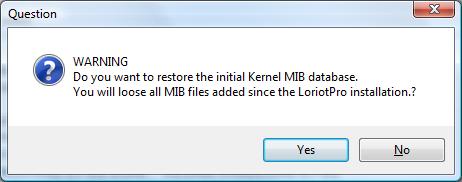
A popup windows informs that LoriotPro must be restarted for the change to take effect.
The MIB database is loaded in working memory from a file when LoriotPro starts, hence the need to restart LoriotPro.
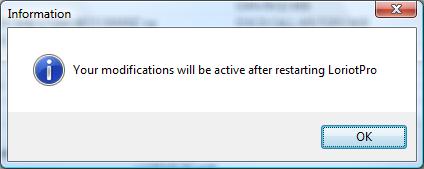
A checking is performed by opening the MIB tree. The following minimum tree must be displayed if the operation went well.
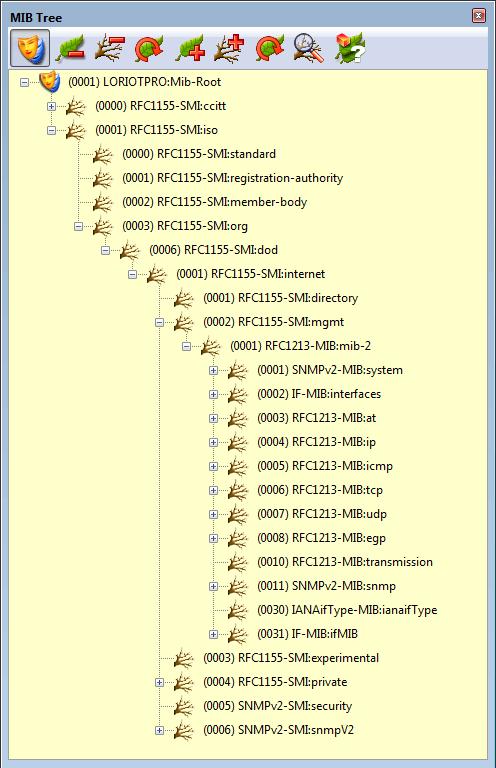
It is possible at this stage to add MIB by compilation, but be careful, because any MIB file compiled by error can be removed when taking the cleaning process.
Control the MIB branch private.enterprises
It is possible to clean the branch private.enterprises which is initialized by default with many entries.
Please note that removing entries prevents LoriotPro to identify the source of equipment or system by its SNMP sysObjectID.
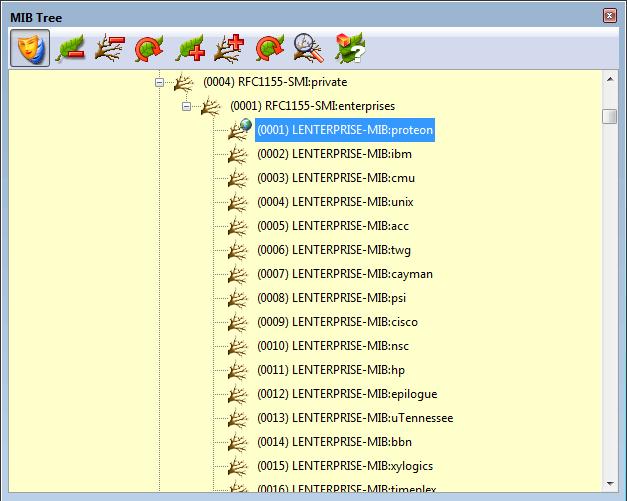
To do this it is necessary to edit the file /bin/config/loriotpro.ini, to find the line (enterprises-number.mib) and to delete it.
The file enterprises-number.MIB located in /bin/mib directory must be removed from the directory or at the next global compilation unwanted entries will be added.
Finally, it a Reset Startup Database to Kernel as explained above.
The common compilation errors are listed below. These error are visible in the log file that is displayed after a compilation.
Search the following line for finding the statistics about the compilation
Total : Node [13025/13024] Node Error [1] Node Warning [0] Token Registered [268] 1 s Tue Jan 13 14:02:35 2004
The Node error should give you 0 else you probably have at least one of the following message before.
Node Father not found for NODE xxxx
The missing father node is a common error message. When you get it you should
find the MIB file that contains the father object required for compiling one
of your MIB file. A MIB file generally describes a node (branch) of the MIB
tree. A node could be compiled if its father node is describe in another MIB file.
Warning OBJECT IDENTIFIER [object] Already Registered
for MIB File xxx
This warning message informs you that the MIB compiler has tried to add an
object that is already defined in another MIB file. It will not be added a
second time.
Error PARSE for object->INTEGER delete sequence
The object parser has found an error in the definition of an object. Verify
that the ASN1 standard is respected.
 www.loriotpro.com
www.loriotpro.com |
|